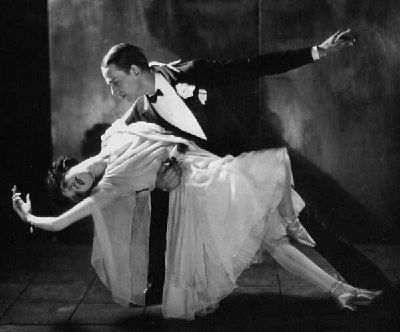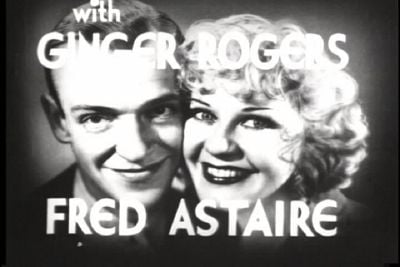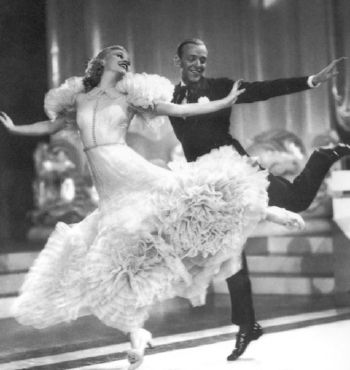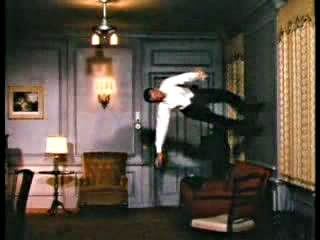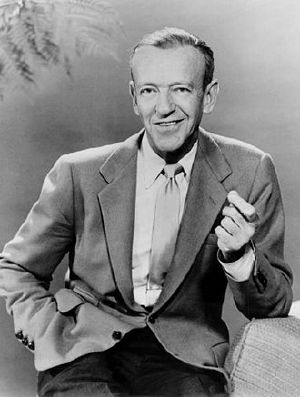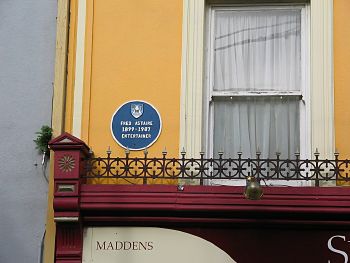Fred Astaire
| Fred Astaire | |
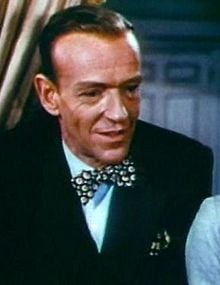 Fred Astaire in Royal Wedding (1951). | |
| Birth name: | Frederick Austerlitz Jr. |
|---|---|
| Date of birth: | May 10, 1899 |
| Birth location: | Omaha, Nebraska, USA |
| Date of death: | June 22 1987 (aged 88) |
| Death location: | Los Angeles, California, USA |
| Academy Awards: | Academy Honorary Award 1950 Lifetime Achievement |
| Spouse: | Phyllis Livingston Potter (1933-1954) Robyn Smith (1980-1987) |
Fred Astaire (May 10, 1899 ‚Äď June 22, 1987) was an American film and Broadway stage dancer, choreographer, singer and actor whose theater, film and, later, television career spanned a total of 76 years, during which time he helped to define the genre of musical films. In the 1930s, his legendary pairing with Ginger Rogers at the zenith of Hollywood extravaganza movie-making become an iconic symbol of style, grace, and charm that set a standard for dance that is still admired and emulated today. Their film Top Hat, along with films such as Swing Time and Shall We Dance, endeared them to Americans searching for lost idealism - and happy endings - after the Great Depression.
During his long career he also worked with some of the great composers and songwriters of the era such as Irving Berlin, George Gershwin and Cole Porter.
After the popularity of musicals waned, Astaire went on to develop a highly respected career in films appearing in The Towering Inferno (1975) and The Man in the Santa Claus Suit (1980). His numerous television appearances included specials such as An Evening with Fred Astaire, which won him an Emmy award (1958) and That's Entertainment! (1975).
Astaire, although being partnered with a wide range of talented dancers and actresses that included Cyd Charisse, Audrey Hepburn, Rita Hayworth, Judy Garland, and Leslie Caron, was a dedicated family man who remained true to the values of his Midwestern upbringing.
Early life and career
He was born, Frederick Austerlitz on May 10, 1899 in Omaha, Nebraska. His father was an Austrian immigrant and a Catholic; his mother was born in the U.S. to Lutheran German parents. Hoping for a theater career for her children, Astaire's mother left for New York City in 1904 with him and his sister Adele. His father stayed behind to support the family. They attended Claude Alvienne's Dancing School on 8th Avenue and soon began touring with acts that included, along with the brother/sister team, jugglers, comedians, ventriloquists, illusionists, contortionists and singers. Their career experienced many starts and stops and was partly circumvented by the Gerry Organization, which sought to prevent exploitation of child actors. An early influence on the young Vaudeville brother/sister team was Bill Robinson, sometimes called the father of tap dance, whose most remembered pairing was with child star Shirley Temple.
Their first Broadway break came when Astaire was seventeen and performed in Over The Top in 1917, soon followed by Apple Blossoms and The Passing Show of 1918. In a few years the pair would leave for the London stage where their act matured and won popular acclaim with European theater goers. Stop Flirting introduced Gershwin's number 'I'll build a stairway to Paradise,' and they would team again back in New York in Lady Be Good! in 1924. This was to be the first of a new style of Broadway musicals, that were more sophisticated and featured the tunes of uniquely American composers such as George Gershwin, Cole Porter and Jerome Kern.
In 1932 Funny Face and The Band Wagon were clear hits on both sides of the Atlantic and Adele decided to retire at the peak of her career in order to marry her first husband, Lord Charles Cavendish. Fred went on to achieve success on his own on Broadway and in London with Gay Divorcee (1932) while considering offers from Hollywood. Approaching the age of thirty, and after having danced with his sister for nearly twenty five years, he resisted the idea of being paired with only one person. However, Astaire's most iconic act was soon to be discovered through a fortuitous pairing with Ginger Rogers in 1933.
Fred and Ginger - The 1930s
The movie that launched the pair as a dancing phenomenon was Flying Down to Rio, (1933) starring Dolores Del Rio, and the scene that was to become a classic was their routine, 'The Carioca' called a 'technically brilliant masterpiece' by Astaire's biographer.[1]The dance, some of it staged on top of seven grand pianos, was a blend of rumba and Brazilian rhythms. It was also the first pairing of Astaire with choreographer Hermes Pan. Not only did the two enjoy a lifelong friendship but together they shared an obsession for working dance routines through to perfection. The movie established Astaire's debonair image, which included his trademark look of elegant evening suits and top hats.
Over the next six years ten films pitted the perfectionistic Astaire with the relaxed and confident Rogers. It was not just their dancing, but their special chemistry together that made their roles in films like The Gay Divorcee (1934), Roberta (1935), Follow the Fleet (1936), Swing Time (1936), Shall We Dance (1937), and Carefree (1938), so successful. The most profitable of all the Astaire-Rogers pairings during the 1930s was Top Hat (1935), a product of teamwork that included Hermes Pan and producer Pandro Berman for RKO.
Speaking of the unique chemistry that existed between Astaire and Rogers, his biographer said, "By 1980s standards their dancing was sexless, yet in the twirling movements, the angle of the body, the juxtaposition of the two dancers and often by the sheer energy, vitality and excitement of their movements, there existed a distinct, if clean, kind of sensuality."[1]
Their final movie together during the 1930s was The Story of Vernon and Irene Castle, a special tribute to another dancing couple, the Castles, who pioneered ballroom dance in America. As the United States entered World War II studios were reluctant to spend money on movie extravaganzas and Astaire and Rogers looked to other projects and solo careers. However, in 1949 they re-united for one final time in the Barkleys of Broadway which featured the famous Gershwin tune, You Can't Take That Away From Me.
Style and Influences
Astaire is credited with two important innovations in early film musicals. First, his insistence that the (almost stationary) camera film a dance routine in a single shot, if possible, while holding the dancers in full view at all times. Astaire famously quipped:"Either the camera will dance, or I will."[2]
Astaire's style of dance sequences contrasted with the Busby Berkeley musicals, which were known for dance sequences filled with extravagant aerial shots, quick takes, and zooms on certain areas of the body, such as the arms or legs. Also Astaire was adamant that all song and dance routines be seamlessly integrated into the plot lines of the film. Instead of using dance as mere spectacle, Astaire used it to move the plot along. Another important element that set Astaire apart was his ability to dance with his entire body. His sense of lightness, his grace, and his ability to communicate with every part of his being, including his eyes, set him apart in both ability, flair and style.
Astaire was a virtuoso dancer who was able to convey both a lighthearted attitude and a deep emotional moment. His technical control and sense of rhythm were impeccable. According to one anecdote, he was able, when called back to the studio to redo a dance number he had filmed several weeks earlier, to reproduce the routine with pinpoint accuracy, down to the last gesture. Astaire's execution of a dance routine was prized for its elegance, grace, originality and precision. He drew from a variety of influences, including tap and other African-American rhythms, classical dance and the elevated style of Vernon and Irene Castle, to create a uniquely recognizable dance style which greatly influenced the American Smooth style of ballroom dance, and set standards against which subsequent filmed dance musicals would be judged.
Astaire introduced some of the most celebrated songs from the Great American Songbook, including Cole Porter's: "Night and Day" from Gay Divorce (1932); Irving Berlin's "Isn't it a Lovely Day," "Cheek to Cheek" and "Top Hat, White Tie and Tails" from Top Hat (1935). He first presented Jerome Kern's "The Way You Look Tonight" from Swing Time 1936); and "Nice Work if You Can Get it" from A Damsel in Distress (1937). He also introduced Johnny Mercer's "One for My Baby" from The Sky's the Limit (1943) and "Something's Gotta Give" from Daddy Long Legs (1955) along with Harry Warren and Arthur Freed's "This Heart of Mine" from Ziegfeld Follies (1946).
Although he possessed a light voice, he was admired for his lyricism, diction and phrasing[3] - The grace and elegance so prized in his dancing seemed to be reflected in his singing, a capacity for synthesis which led Burton Lane to describe him as, The world's greatest musical performer.[4] Irving Berlin considered Astaire the equal of any male interpreter of his songs and George Gershwin said of him, "I'd rather have Astaire introduce my songs than any other performer."[1]
Later Musicals - the 1940s and 1950s
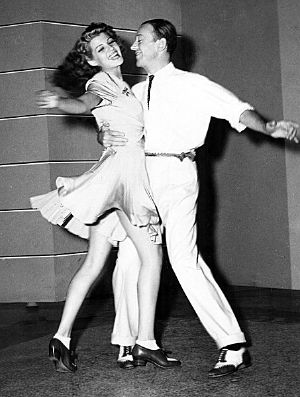
In 1939, Astaire left RKO Pictures to freelance and pursue new film opportunities. He teamed up with other stars, notably with Bing Crosby in Holiday Inn (1942) and later Blue Skies (1946). One of his first post-Rogers dance partners was Eleanor Powell, with whom he appeared in Broadway Melody of 1940. Other partners during this period included Paulette Goddard in Second Chorus (1940), Rita Hayworth in You'll Never Get Rich (1941) and You Were Never Lovelier (1942), Joan Leslie in The Sky's the Limit (1943), and Lucille Bremer in Yolanda and the Thief (1945). Ziegfeld Follies (1946) contains a memorable teaming of Astaire with Gene Kelly.
After announcing his retirement with Blue Skies in 1946, Astaire concentrated on his horse-racing interests and went on to found the Fred Astaire Dance Studios in 1947 - which he subsequently sold in 1966. However he soon returned to the big screen to replace the injured Gene Kelly in Easter Parade (1948) opposite Judy Garland and Ann Miller. He then went on to make more musicals throughout the 1950s including: Let's Dance (1950) with Betty Hutton, Royal Wedding (1951) with Jane Powell, The Belle of New York (1952) with Vera Ellen, Silk Stockings (1957) with Cyd Charisse, Daddy Long Legs (1955) with Leslie Caron, and Funny Face (1957) with Audrey Hepburn. His legacy at this point was 30 musical films in a 25-year period.
Astaire later concentrated on dramatic acting and scored rave reviews for the nuclear war drama On the Beach (1959).
Transition to television and later films
Astaire did not give up dancing completely nor did he ever retire completely, though his pace slowed down. He made a series of four highly rated, Emmy award-winning musical specials for television in 1958, 1959, 1960, and 1968, each featuring Barrie Chase. The first of these programs, An Evening with Fred Astaire, (1958) won nine Emmy Awards, including "Best Single Performance by an Actor" and "Most Outstanding Single Program of the Year." It was also noteworthy for being the first major broadcast to be prerecorded on color videotape.
Astaire's last major musical film was Finian's Rainbow (1968), in which he shed his white tie and tails to partner with singer Petula Clark. Astaire continued to act into the 1970s, appearing in films such as The Towering Inferno (1974), for which he received his only Academy Award nomination in the category of Best Supporting Actor. He appeared in the first two That's Entertainment! documentaries in the mid-1970s. In the second, aged seventy-seven, he performed a number of song-and-dance routines with Gene Kelly‚ÄĒhis last dance performances in a musical film. In 1976 he recorded a disco-styled rendition of Carly Simon's "Attitude Dancing." In 1978 Fred Astaire co-starred with Helen Hayes in a well-received television film, A Family Upside Down, in which they play an elderly couple coping with failing health. Astaire won an Emmy Award for his performance. He made a well-publicized guest appearance on the science fiction TV series Battlestar Galactica in 1979. His final film was the 1981 adaptation of Peter Straub's Ghost Story.
Marriages and family life
Astaire married for the first time in 1933, to Phyllis Potter (née Phyllis Livingston Baker, 1908-1954), a Boston-born New York socialite and former wife of Eliphalet Nott Potter III (1906-1981). In addition to Phyllis' son, Eliphalet IV, known as Peter, the Astaires had two children, Fred Jr. (born 1936, he appeared with his father in the movie Midas Run but became a charter pilot and rancher instead of an actor), and Ava, Mrs. Richard McKenzie (born 1942). The death of his wife in 1954 of a brain tumor was a traumatic experience for Astaire; he sought refugee with family, friends and his church, and remained a bachelor for many years thereafter. Close friend David Niven said of the couple, "Theirs was the prototype of a gloriously happy marriage."[1]
Astaire was a lifelong [golf]] and horse-racing enthusiast, whose horse Triplicate won the 1946 Hollywood Gold Cup. He remarried in 1980, to Robyn Smith, a champion jockey almost 45 years his junior.
Fred Astaire died in 1987 from pneumonia at the age of 88 and was interred in the Oakwood Memorial Park Cemetery in Chatsworth, California. One of his last requests was to thank his fans for their years of support.
Legacy
He did not have the classic looks of a Hollywood hero, nor a powerful voice, but his style, infectious smile, and easy grace gave him something above and beyond what other leading men portrayed and that was charm, originality and style. After winning the ice dancing championships in 1984 Christopher Dean and Jayne Torville revealed that they gained their inspiration from watching Astaire's 1930 Hollywood musicals.
His perfectionism was legendary as was his modesty and consideration towards his fellow artists. In his 1960 autobiography, Steps in Time, he expressed his straightforward view, I am often asked to expound on the history and philosophy of "the dance" about which I have disappointingly little to say…. I don't know how it all started and I don't want to know. I have no desire to prove anything by it. I have never used it as an outlet or as a means of expressing myself. I just dance."[1]
He also exercised control not only over his artistry but over the filming, editing and cutting of his dance sequences and complete autonomy over how the dances would be presented, allowing him to revolutionize dance on film. His partnership with Hermes Pan helped make dancing an important element of the Hollywood film musical.
He was named the fifth Greatest Male Star of All Time by the American Film Institute.
Awards and honors
Fred Astaire, through his career has acrued the following awards and honors:[5]
- (1938) - Invited to place his hand and foot prints in cement at Grauman's Chinese Theatre, Hollywood.
- (1950) - Ginger Rogers presented an honorary Academy Award to Astaire "for his unique artistry and his contributions to the technique of musical pictures."
- (1950) - Golden Globe for "Best Motion Picture Actor -Music/Comedy" for Three Little Words.
- (1958) - Emmy Award for "Best Single Performance by an Actor" for An Evening with Fred Astaire.
- (1959) - Dance Magazine award.
- (1960) - Nominated for Emmy Award for "Program Achievement" for Another Evening with Fred Astaire.
- (1960) - Golden Globe Cecil B. DeMille Award for "Lifetime Achievement in Motion Pictures."
- (1961) - Emmy Award for "Program Achievement" in 1961 for Astaire Time.
- (1961) - Voted Champion of Champions - Best Television performer in annual television critics and columnists poll conducted by Television Today and Motion Picture Daily.
- (1965) - The George Award from the George Eastman House for "outstanding contributions to motion pictures."
- (1968) - Nominated for an Emmy Award for Musical Variety Program for The Fred Astaire Show.
- (1972) - Named Musical Comedy Star of the Century by Liberty Magazine.
- (1973) - Subject of a Gala by the Film Society of Lincoln Center.
- (1975) - Golden Globe for "Best Supporting Actor," BAFTA and David di Donatello awards for The Towering Inferno.
- (1978) - Emmy Award for "Best Actor - Drama or Comedy Special" for A Family Upside Down.
- (1978) - Honored by the Academy of Television Arts & Sciences.
- (1978) - First recipient of the Kennedy Center Honors.
- (1978) - National Artist Award from the American National Theatre Association for "contributing immeasurably to the American Theatre."
- (1981) - The Lifetime Achievement Award from the AFI.
- (1987) - The Capezio Dance Shoe Award (co-awarded with Rudolph Nureyev).
- (1989) - Posthumous award of Grammy Lifetime Achievement Award.
- (1991) - Posthumous induction into the Ballroom Dancer's Hall of Fame.
- (2000) - Ava Astaire McKenzie unveils a plaque in honour of her father, erected by the citizens of Lismore, County Waterford, Ireland.
Filmography
(*) w/ Ginger Rogers |
|
Television work
|
|
Notes
- ‚ÜĎ 1.0 1.1 1.2 1.3 1.4 Peter Carrick, A Tribute to Fred Astaire (Salem House, 1984, ISBN 0881620815).
- ‚ÜĎ John Mueller, Astaire Dancing - The Musical Films. (London: Hamish Hamilton, 1986, ISBN 0241117496).
- ‚ÜĎ Bob Thomas, Astaire, the Man, The Dancer (London: Weidenfeld & Nicolson, 1985, ISBN 0297784021), 118.
- ‚ÜĎ Mueller 21.
- ‚ÜĎ Larry Billman, Fred Astaire - A Bio-bibliography (Greenwood Press, 1997, ISBN 0313290105), 287-290.
ReferencesISBN links support NWE through referral fees
- Astaire, Fred. Steps in Time. New York: Harper Entertainment, 2008. ISBN 978-0061567568
- Billman, Larry. Fred Astaire - A Bio-bibliography. Greenwood Press, 1997. ISBN 0313290105
- Boyer, G. Bruce. Fred Astaire Style. Assouline, 2005. ISBN 2843236770
- Carrick, Peter. A Tribute to Fred Astaire. Salem House,1984. ISBN 0881620815
- Croce, Arlene. The Fred Astaire and Ginger Rogers Book. Galahad Books, 1974. ISBN 0883650991
- Freeland, Michael. Fred Astaire An Illustrated Biography. Grosset & Dunlap, 1976. ISBN 0448140802
- Gallafent, Edward. Astaire and Rogers. New York: Columbia University Press, 2002. ISBN 0231126263
- Giles, Sarah. Fred Astaire - His Friends Talk. Doubleday, 1988. ISBN 0747503222
- Green, Benny. Fred Astaire. Bookthrift Co., 1980. ISBN 0896730182
- Green, Stanley, and Burt Goldblatt. Starring Fred Astaire. Dodd, 1973. ISBN 0396068774
- Hyam, Hannah. Fred and Ginger - The Astaire-Rogers Partnership 1934-1938. Brighton, UK: Pen Press Publications, 2007. ISBN 978-1905621965
- Lamparski, Richard. Manhattan Diary. BearManor Media, 2006. ISBN 1593930542
- Mueller, John. Astaire Dancing - The Musical Films. London: Hamish Hamilton, 1986. ISBN 0241117491
- Thomas, Bob. Astaire, the Man, The Dancer. London: Weidenfeld & Nicolson, 1985. ISBN 0297784021
- Satchell, Tim. Astaire, The Biography. London: Hutchinson, 1987. ISBN 0091737362
External links
All links retrieved April 11, 2024.
- Fred Astaire IMDb
- Fred Astaire IBDb
- Fred Astaire biography AllMovie
- Fred Astaire Find A Grave
| Songwriters |
|
Arlen | Berlin | Blane | Cahn | Carmichael | Coleman | Dietz | Ellington | Fain | Fields | G. Gershwin | I. Gershwin | Hammerstein | Hart | Kern | Lerner | Loewe | Loesser | Mancini | Mandel | Martin | Mercer | McHugh | Porter | Rodgers | Schwartz | Styne | Webster |
| Singers |
|
Anka | Armstrong | Astaire | Bennett | Boswell | Boswells | Brice | Bublé | Carter | Clooney | Cole | Como | Connick | Crosby | Day | Dearie | Eckstine | Faye | Feinstein | Fitzgerald | Francis | Garland | Holiday | Horn | Horne | Keel | Kelly | Krall | Laine | Lamour | Lee | Manilow | Martin | Mathis | McRae | Midler | Nilsson | Page | Rogers | Shore | Simone | Sinatra | Stafford | Stewart | Streisand | Tormé | Vaughan | Washington | Williams |
Credits
New World Encyclopedia writers and editors rewrote and completed the Wikipedia article in accordance with New World Encyclopedia standards. This article abides by terms of the Creative Commons CC-by-sa 3.0 License (CC-by-sa), which may be used and disseminated with proper attribution. Credit is due under the terms of this license that can reference both the New World Encyclopedia contributors and the selfless volunteer contributors of the Wikimedia Foundation. To cite this article click here for a list of acceptable citing formats.The history of earlier contributions by wikipedians is accessible to researchers here:
The history of this article since it was imported to New World Encyclopedia:
Note: Some restrictions may apply to use of individual images which are separately licensed.
